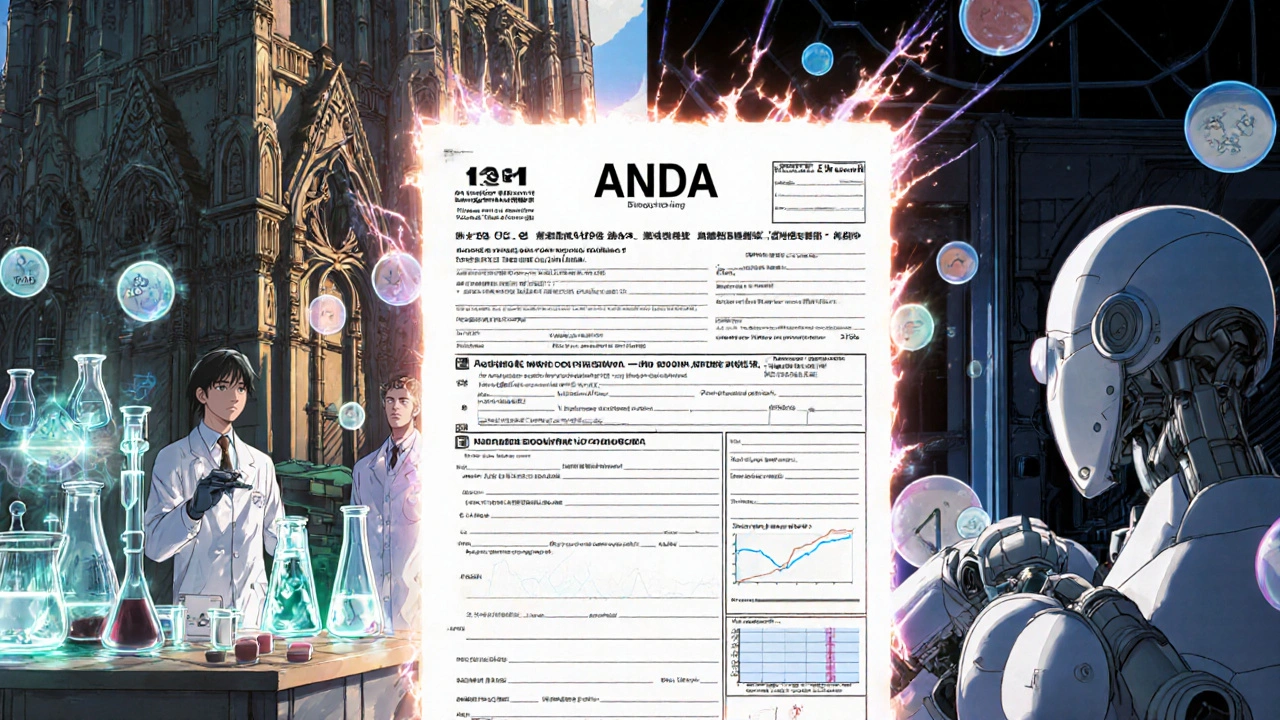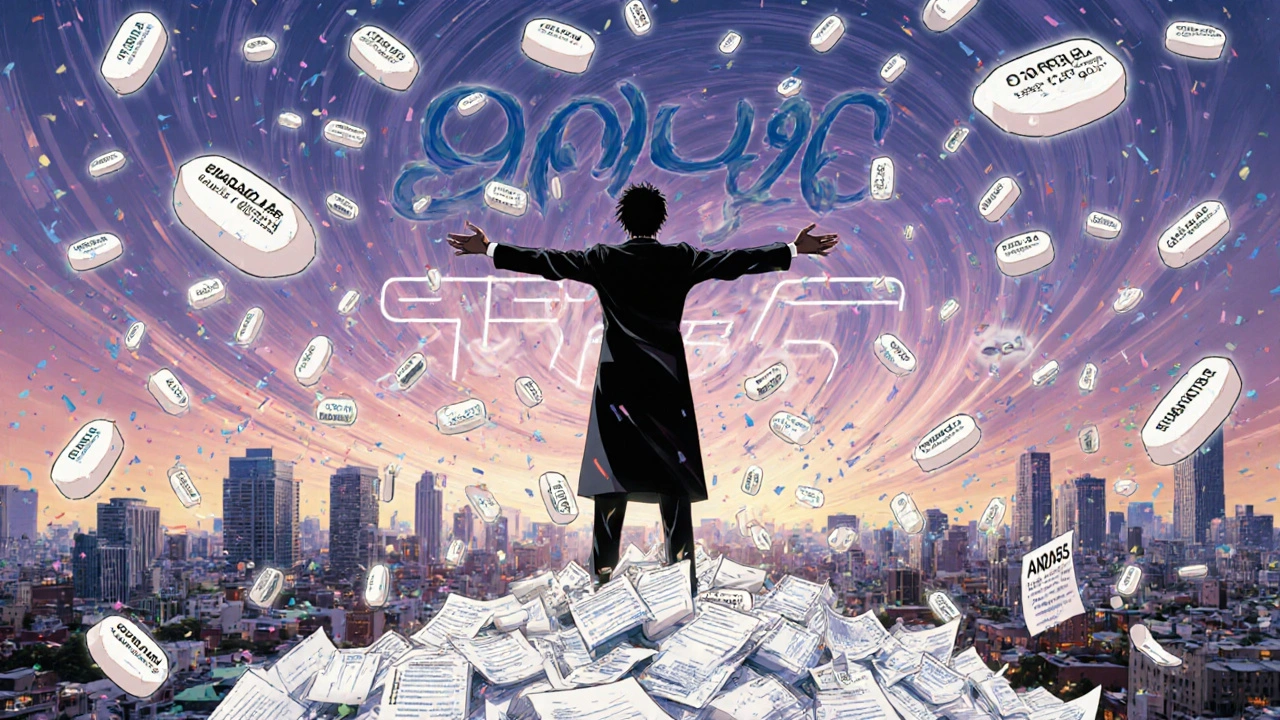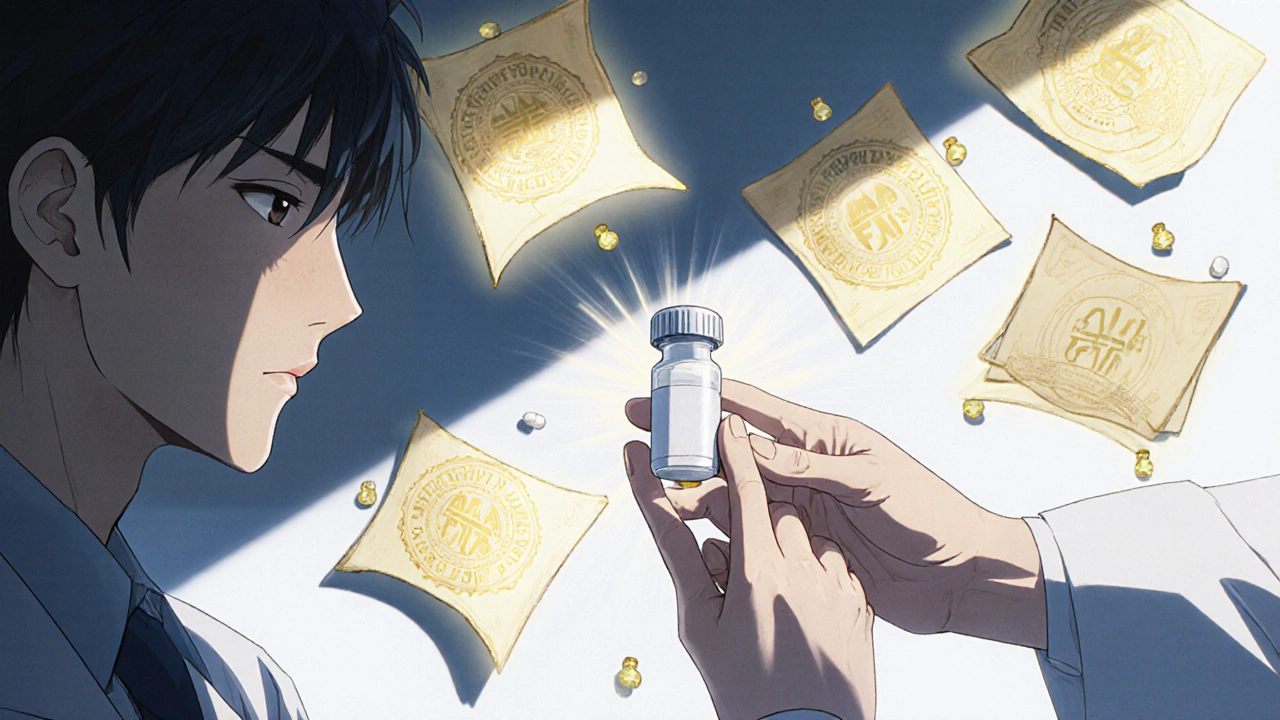Every time you pick up a generic pill at the pharmacy and pay a fraction of what the brand-name version costs, you’re benefiting from something called an ANDA. But what exactly is an ANDA? It’s not a drug. It’s not a company. It’s a paperwork pathway - one of the most important, yet least understood, systems keeping prescription drugs affordable in the United States.
What Does ANDA Stand For?
ANDA stands for Abbreviated New Drug Application. It’s the official form that generic drug manufacturers submit to the U.S. Food and Drug Administration (FDA) to get permission to sell a copy of a brand-name drug after its patent expires.
Think of it like this: The original drug company spent years and billions of dollars developing a new medicine. They ran clinical trials, proved it was safe, and got FDA approval through a full New Drug Application (NDA). Once their patent runs out, other companies can make the same drug - but they don’t need to repeat all that expensive testing. That’s where the ANDA comes in. It’s "abbreviated" because it skips the long, costly clinical trials. Instead, it proves the generic version is the same in every way that matters.
How Is an ANDA Different From an NDA?
The key difference is data. A New Drug Application (NDA) needs full proof of safety and effectiveness from scratch - animal studies, Phase I, II, and III human trials, long-term monitoring. That process takes 10 to 15 years and costs about $2.6 billion.
An ANDA doesn’t need any of that. Instead, it must show three things:
- The generic drug has the same active ingredient as the brand-name drug.
- It’s the same strength, dosage form (pill, injection, cream, etc.), and way it’s taken (oral, topical, etc.).
- It works the same way in the body - meaning it’s bioequivalent.
For bioequivalence, the FDA requires studies with 24 to 36 healthy volunteers. These studies measure how quickly and how much of the drug enters the bloodstream. The generic’s absorption rate must fall within 80% to 125% of the brand-name drug’s. That’s not a guess - it’s a strict scientific standard backed by decades of data. If it passes, the FDA says the generic is therapeutically equivalent. That means you can swap it in without any change in how well it works or how safe it is.
Why Was the ANDA Pathway Created?
The ANDA system didn’t exist until 1984. Before then, generic drugs were rare. Even after a patent expired, companies couldn’t easily copy the drug because they had to prove safety and effectiveness all over again - which was too expensive for most.
The Hatch-Waxman Act of 1984 changed that. It created the ANDA pathway to balance two goals: letting generic companies enter the market quickly, and protecting the original drugmakers’ innovation. The result? Today, 90% of all prescriptions in the U.S. are filled with generic drugs. And they cost 80% to 85% less than the brand names.
Over the past decade, generic drugs saved the U.S. healthcare system more than $2.2 trillion. That’s not just money in patients’ pockets - it’s millions of people who can actually afford their medicine.
What’s Inside an ANDA Submission?
An ANDA isn’t just a form. It’s a massive package of technical data. Here’s what’s required:
- Active ingredient: Must match the brand-name drug exactly - same chemical structure, same purity.
- Inactive ingredients: Can be different (like fillers or dyes), but they can’t affect how the drug works or cause safety issues.
- Manufacturing process: Must be detailed enough to prove consistency. Every batch must be the same.
- Quality control: Testing methods for potency, stability, and contamination must meet FDA standards.
- Stability data: Shows the drug won’t break down over time under normal storage conditions.
- Labeling: Must match the brand-name drug’s labeling, except for the brand name and manufacturer info.
Each approved ANDA gets a unique six-digit number - like ANDA 214455 for the generic version of Eliquis. You can look up any approved ANDA on the FDA’s Drugs@FDA database.

Who Uses the ANDA Pathway?
Almost every generic drug maker in the U.S. relies on it. The big players - Teva, Viatris, Sandoz, and Mylan - submit hundreds of ANDAs each year. But smaller companies use it too. In fact, 98% of all generic drugs approved in the U.S. enter through the ANDA pathway.
It’s not just for simple pills. The FDA has expanded the ANDA process to include complex products like inhalers, topical creams, and nasal sprays. These are harder to copy because small changes in formulation can change how the drug works. The FDA now has special guidance for these - but the core rule stays the same: prove equivalence.
How Long Does ANDA Approval Take?
Under the Generic Drug User Fee Amendments (GDUFA), the FDA aims to review a standard ANDA in 10 months. That’s faster than the review time for many brand-name drugs.
But approval isn’t guaranteed. About 35% of first-time ANDAs get a "complete response letter" - meaning the FDA needs more information. The most common reasons? Inadequate manufacturing controls (32% of cases) or weak bioequivalence data (27%).
Companies with experienced regulatory teams have a much higher success rate. Those with dedicated ANDA experts see first-cycle approval rates of 42%, compared to 28% for those without.
What About Patents and Exclusivity?
One of the trickiest parts of filing an ANDA is dealing with patents. The Hatch-Waxman Act requires generic companies to certify how they’re handling each patent listed for the brand-name drug in the FDA’s Orange Book.
You can certify that:
- The patent has expired.
- The patent will expire soon.
- The patent is invalid.
- There’s no patent infringement.
If you claim the patent is invalid or not infringed, the brand-name company can sue. That triggers a 30-month stay - meaning the FDA can’t approve your ANDA until the legal battle is settled. This is why the first company to challenge a patent often gets 180 days of exclusive rights to sell the generic - a huge financial incentive.
That’s what happened with Humira (adalimumab). When its patents expired in 2023, 12 generic versions were approved at once, thanks to this system.

Are Generic Drugs Really the Same?
Yes. And the data backs it up.
Studies show that generic drugs approved through the ANDA pathway have a 97% therapeutic equivalence rate compared to brand-name drugs. That means in 97 out of 100 cases, they work the same way in real-world use.
Patients don’t notice a difference. Doctors don’t see a drop in effectiveness. And the FDA continues to monitor safety after approval. If a generic causes unexpected problems, the FDA can pull it from the market - just like a brand-name drug.
The biggest difference? Price. And that’s the whole point.
Challenges and Future of the ANDA Pathway
It’s not perfect. Some manufacturers struggle with complex drugs - especially those with tricky delivery systems. Bioequivalence studies for inhalers or topical gels are harder to design and interpret. The FDA is working on new guidance to help, but progress is slow.
Another concern: supply chains. Over half of the ingredients for generic drugs come from just two countries - India and China. A single factory shutdown or quality issue can cause nationwide shortages. Experts warn this creates systemic risk.
Still, the future looks strong. The FDA’s new GDUFA IV goals aim for 90% first-cycle approval rates by 2027. The Congressional Budget Office predicts generic drugs will save the U.S. $1.7 trillion between 2024 and 2033.
The ANDA pathway isn’t flashy. It doesn’t make headlines. But it’s one of the most effective public health tools ever created. It turns expensive, inaccessible medicine into something millions can afford - without cutting corners on safety.
What Happens After ANDA Approval?
Once the FDA approves an ANDA, the generic drug can be sold. But approval isn’t the end - it’s the start of competition.
When the first generic hits the market, prices often drop by 30% to 50%. As more companies enter, prices fall further - sometimes by 80% or more. That’s why the same drug might cost $5 one month and $2 the next.
Pharmacies, insurers, and patients all benefit. And the cycle continues: when a new brand-name drug gets approved, it eventually becomes a target for an ANDA. The system keeps turning.
So next time you get a generic prescription, remember: it’s not a lesser drug. It’s the result of a smart, well-tested system designed to make medicine affordable - without sacrificing safety or effectiveness.
Is an ANDA the same as a generic drug?
No. An ANDA is the application a company submits to the FDA to get approval to make a generic drug. The generic drug is the actual medicine you take. The ANDA is the paperwork that proves it’s safe and effective enough to be sold.
Can any company file an ANDA?
Any company can file, but it’s not easy. They need expertise in pharmaceutical development, manufacturing, and regulatory affairs. The submission requires extensive data on chemistry, bioequivalence, and quality control. Most companies hire specialized regulatory teams to handle it.
Do generic drugs have the same side effects as brand-name drugs?
Yes. Because they contain the same active ingredient and work the same way in the body, generic drugs have the same side effect profile as their brand-name counterparts. Minor differences in inactive ingredients rarely cause issues, but if they do, the FDA tracks and addresses them.
How long does ANDA approval take?
The FDA aims to review a standard ANDA in 10 months under current guidelines. But many applications require additional information, which can delay approval. Companies with experienced teams have higher success rates on the first try.
Are all generic drugs approved through ANDA?
Virtually all small-molecule generic drugs in the U.S. are approved through ANDA. Biosimilars (copies of biologic drugs) follow a different pathway under the BPCIA. Complex generics like inhalers or topical creams are increasingly approved via ANDA, but they require more detailed data.
Can I trust a generic drug from a foreign manufacturer?
Yes. The FDA inspects all manufacturing facilities - whether they’re in the U.S., India, China, or elsewhere - before approving an ANDA. All facilities must meet the same quality standards. The FDA also conducts unannounced inspections and monitors adverse events globally.


Dan Rua
November 25, 2025 AT 21:47